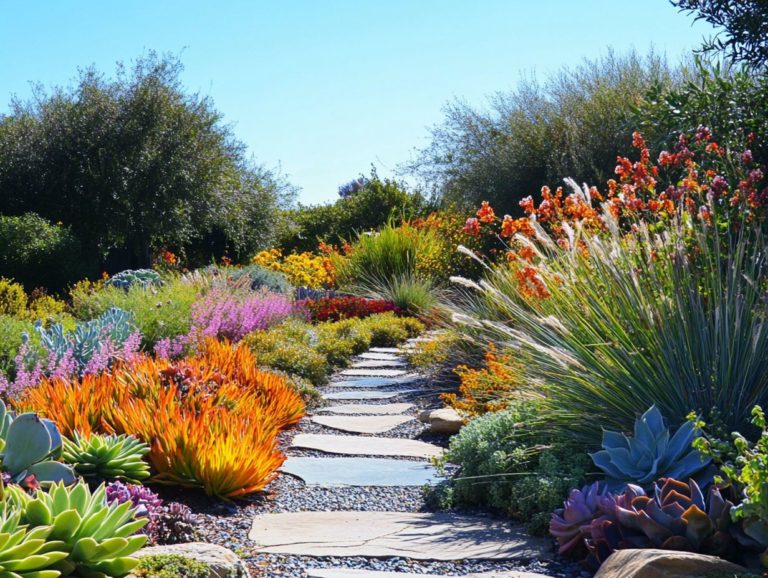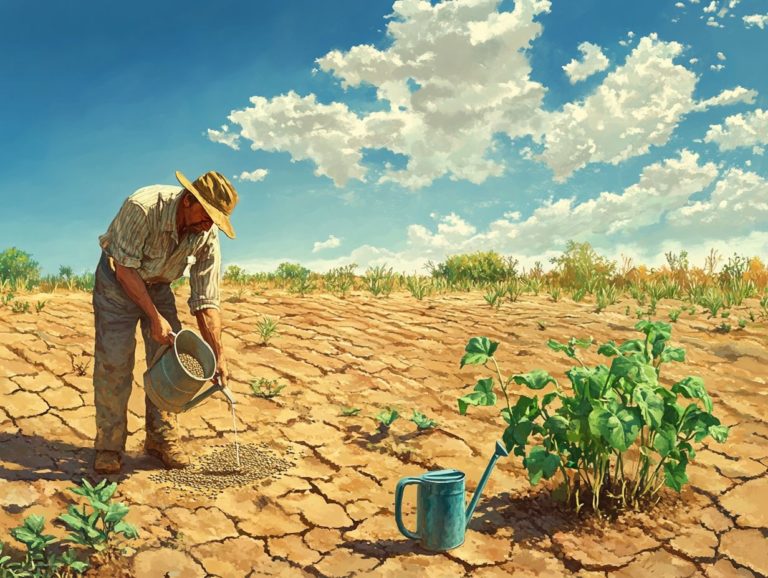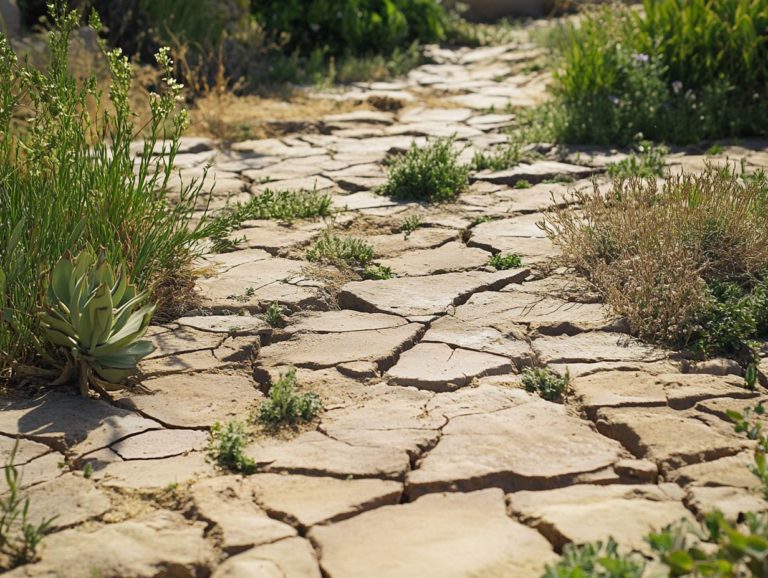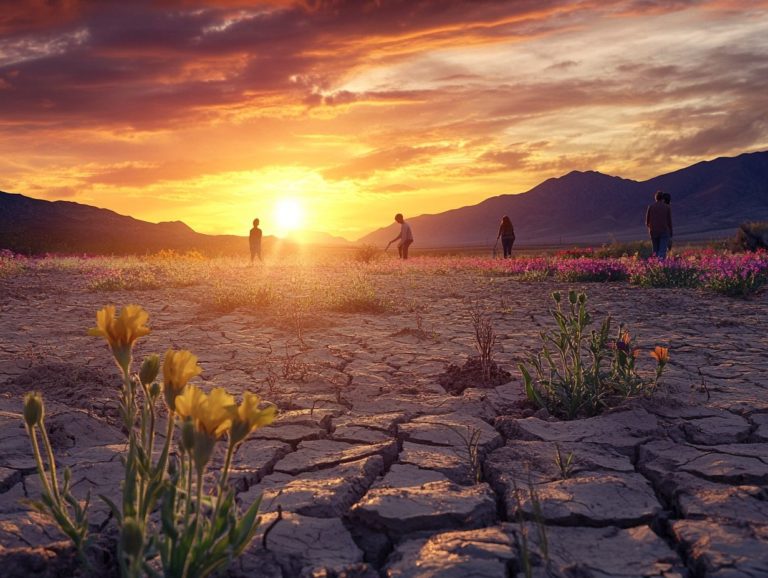The Impact of Drought on Landscaping Choices
Drought has the power to dramatically reshape landscapes, influencing everything from plant health to soil quality. As water scarcity becomes increasingly prevalent, it s crucial for you to understand how to adapt your garden and yard effectively.
This article delves into the impacts of drought on landscaping, showcases drought-resistant plants, and introduces water-saving techniques to ensure your outdoor space remains vibrant.
It also explores alternative landscaping options like xeriscaping, a landscaping method that uses drought-resistant plants to conserve water, providing you with practical tips to keep your landscape flourishing, even in dry conditions.
Contents
- Key Takeaways:
- The Effects of Drought on Landscaping
- Choosing Drought-Resistant Plants
- Water-Saving Landscaping Techniques
- Alternative Landscaping Options
- Maintaining a Drought-Resistant Landscape
- Frequently Asked Questions
- What is the impact of drought on landscaping choices?
- How can drought affect the health of plants in a landscape?
- What are some water-efficient landscaping choices that can help combat drought?
- What are the long-term consequences of not considering drought in landscaping choices?
- Are there any benefits to incorporating drought-resistant landscaping choices?
- How can homeowners and landscapers prepare for and adapt to drought conditions?
Key Takeaways:
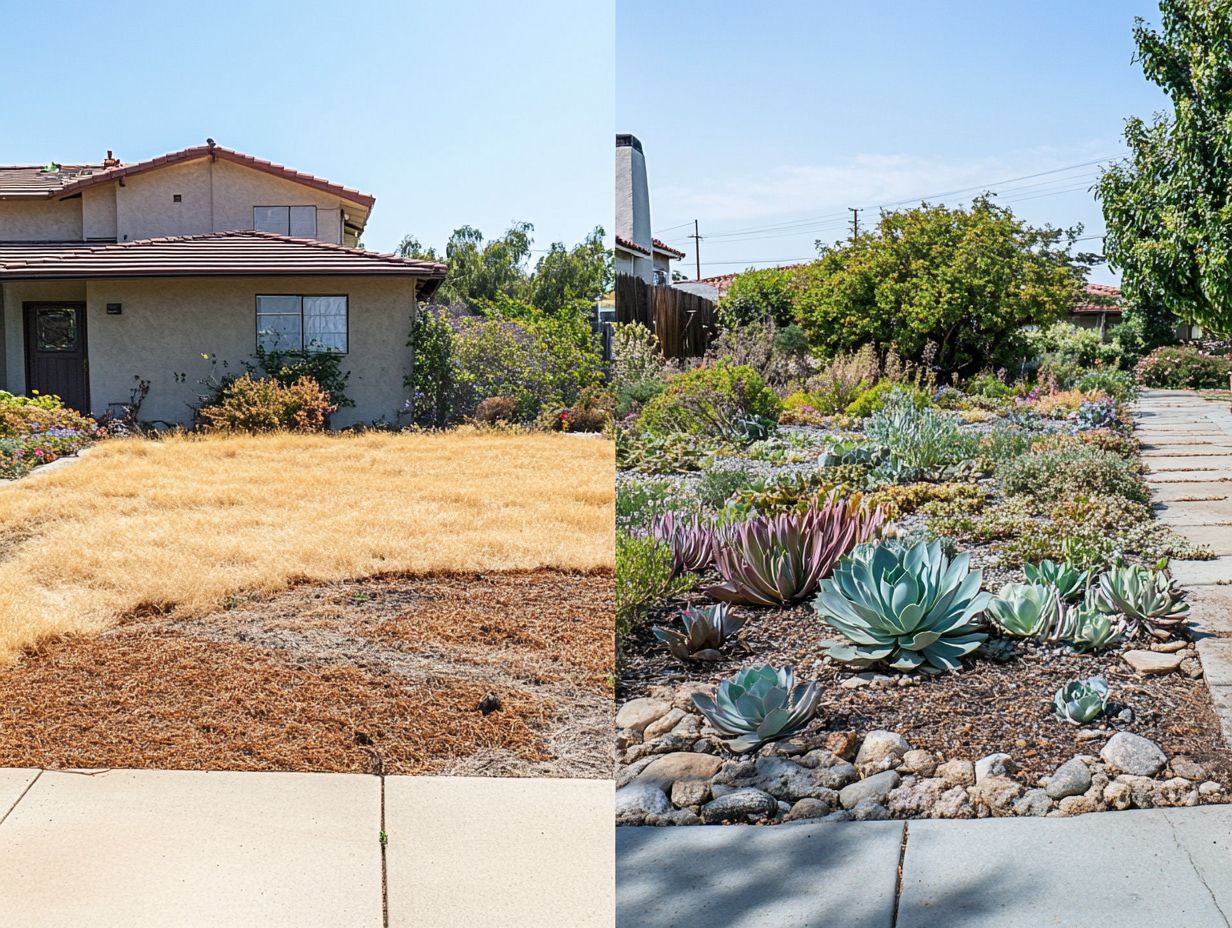
- Choose drought-resistant plants to reduce water usage and maintain a beautiful landscape even during times of drought.
- Implement water-saving landscaping techniques to conserve water and minimize the impact of drought conditions on your landscape.
- Maintain a drought-resistant landscape by regularly monitoring and caring for plants, using mulch, and adjusting watering habits according to weather conditions.
The Effects of Drought on Landscaping
The ongoing drought conditions in California have profoundly influenced landscaping practices, forcing homeowners to rethink their yard design. As drought stress takes a toll on various plant species, it’s essential for you to embrace water-saving techniques and consider using native plants in drought landscapes that bolster climate resilience.
Prioritizing water conservation helps safeguard local ecosystems and ensures that your landscapes remain visually stunning and sustainable, even in the face of challenges presented by extended drought periods and drought stress.
Understanding the Impact on Plants and Soil
Understanding the effects of drought on plants and soil health is essential for you as a homeowner seeking to maintain a vibrant landscape in challenging conditions. Drought can place significant stress on a variety of plant species, leading to stunted growth and heightened vulnerability to pests and diseases.
By recognizing this reality, you can make informed decisions about incorporating drought-tolerant and California native plants into your garden. These plants are naturally suited for arid environments, boasting deep root systems that allow them to tap into groundwater.
Their robust roots enhance soil stability and improve water retention, contributing to a healthier ecosystem. Moreover, adopting water conservation practices, such as mulch and irrigation systems, can further reduce stress on your plants, fostering a sustainable landscape that flourishes even in harsh conditions.
Choosing Drought-Resistant Plants
Choosing drought-resistant plants is vital for homeowners in California aiming to cultivate a sustainable landscape that can endure the challenges posed by climate change and extended drought periods. By opting for drought-tolerant varieties, like succulents and native California flora, you can significantly cut down on water usage.
Moreover, these low-maintenance species support local pollinators and bolster overall soil health. Eco-friendly landscape design is not just a fleeting trend it s an essential strategy for resilient living.
Start transforming your landscape today! Choose drought-resistant plants and save water while keeping your garden beautiful!
Types of Plants that Thrive in Dry Conditions
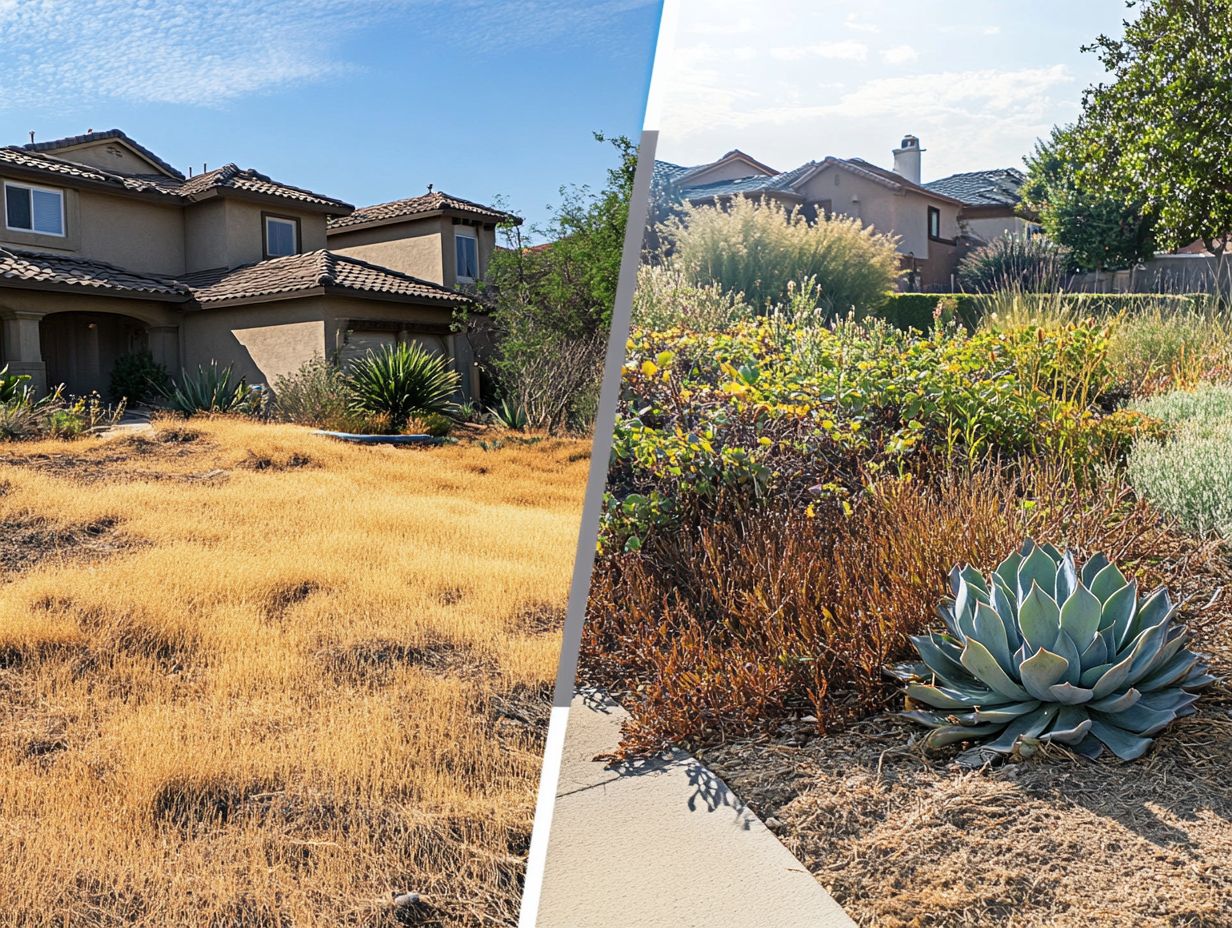
Numerous types of plants thrive in dry conditions, making them ideal choices for establishing a drought-resistant landscape.
These resilient species not only survive but flourish with minimal water. They showcase remarkable adaptations that make them perfect for arid environments. For instance, think about succulents; their thick, fleshy leaves store moisture effectively.
Consider agave plants, which develop deep root systems that tap into underground water sources. Lavender, known for its fragrant flowers, boasts drought-resistant qualities and requires little irrigation once established.
Groundcover plants like creeping thyme spread rapidly, creating a lush carpet. This minimizes soil erosion while retaining moisture.
By incorporating these plants, you enhance your landscape and embrace sustainable practices that are kind to the environment and support soil vitality.
Water-Saving Landscaping Techniques
Transform your outdoor spaces with exciting water-saving landscaping techniques to lower your water bill and enhance the sustainability of your garden amidst California’s</b ongoing drought challenges.
Strategies include installing efficient irrigation systems, which deliver the right amount of water to plants, and utilizing permeable surfaces to elevate your water conservation efforts.
Incorporating hardscape elements supports effective stormwater management and adds visual appeal to your designs. Start today to achieve a perfect balance of beauty and function!
Strategies for Conserving Water in Landscaping
You have a wealth of effective strategies for conserving water in your landscaping. These practices ensure a sustainable and resilient outdoor environment through proper landscape management.
Embrace practices like applying mulch around your plants to retain moisture. Fine-tune your irrigation systems for intelligent watering schedules.
Select low-water designs featuring drought-resistant native plants such as lavender to significantly reduce water consumption.
Regular landscape maintenance, including timely pruning and vigilant monitoring of plant health, is essential for maximizing water efficiency. A well-groomed landscape enhances water absorption and minimizes waste.
These approaches not only bolster conservation efforts but also cultivate a vibrant landscape that dazzles throughout the year.
Alternative Landscaping Options
Explore alternative landscaping options, such as xeriscaping, which conserves water by using drought-resistant plants. This approach transforms your outdoor spaces into drought-friendly designs.
By integrating hardscape elements and reducing water usage, you can craft visually stunning landscapes that are beautiful and functional.
Embrace these eco-friendly practices to enhance your property and foster community engagement. Inspire others to consider responsible landscaping that aligns with water conservation goals.
In conclusion, using drought-resistant plants and water-saving techniques leads to beautiful and sustainable outdoor spaces. Make the change today!
Xeriscaping and Other Drought-Friendly Designs
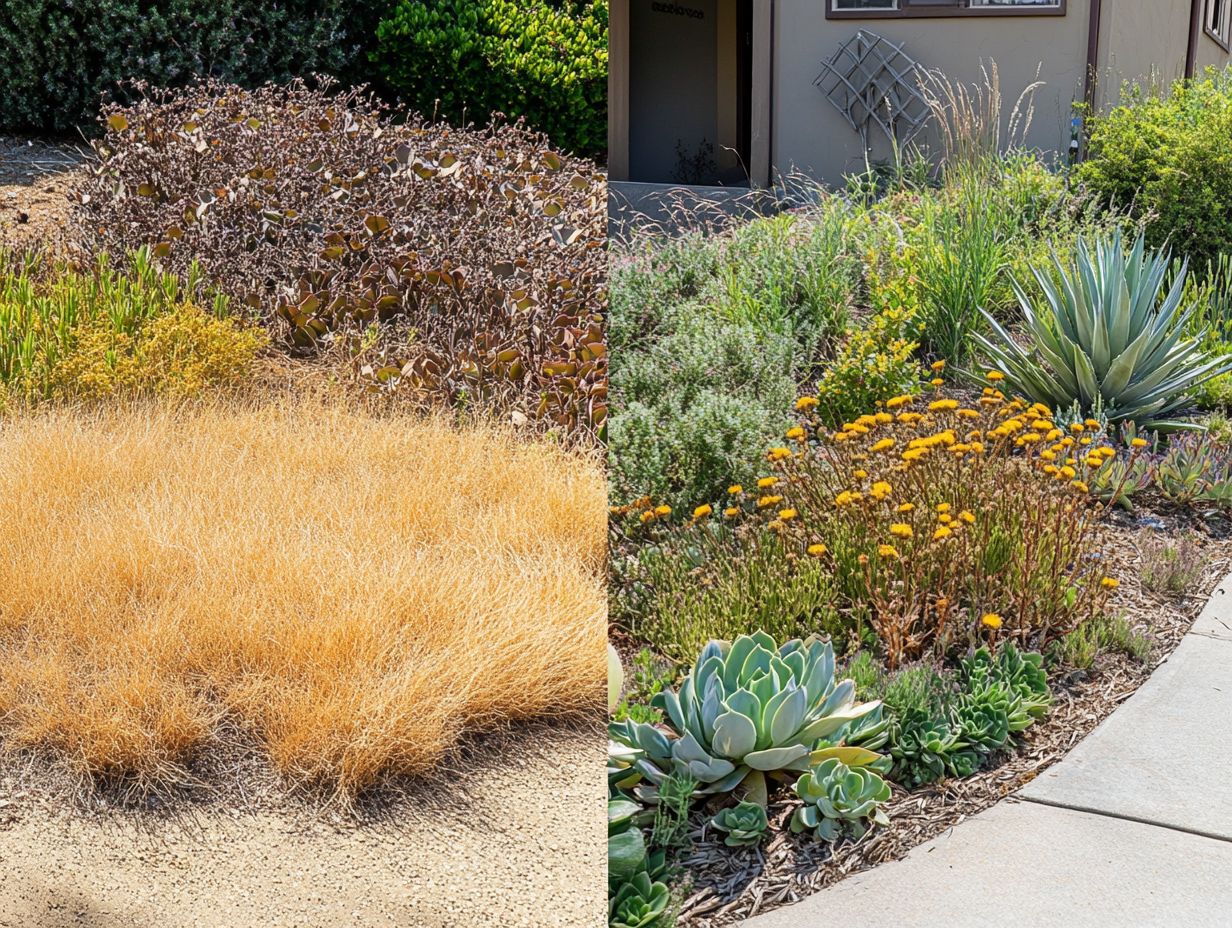
Xeriscaping is an exceptional landscaping approach that allows you to craft stunning, drought-friendly designs using native and drought-resistant plants. This method minimizes water usage.
This method distinctly contrasts with traditional landscaping, which often leans heavily on lush lawns and high-maintenance, water-intensive plants. By embracing xeriscaping principles, you can create beautifully varied landscapes that lessen your ecological footprint and support local biodiversity.
The aesthetic appeal of low-water designs is remarkable. They provide a rich tapestry of textures, colors, and forms that add visual interest throughout the year. These thoughtfully curated gardens enhance your outdoor spaces while conserving precious water resources, demonstrating that beauty and sustainability can truly coexist.
Maintaining a Drought-Resistant Landscape
Maintaining a drought-resistant landscape calls for active management methods that prioritize plant health and sustainability. Homeowners should embrace environmentally friendly methods and establish regular maintenance routines. This allows them to monitor the health of their drought-resistant plants and spot potential issues before they escalate.
This method improves water use. It also makes your landscape more attractive and strong, ultimately safeguarding property value and encouraging responsible landscape design during times of drought.
Tips for Keeping Your Landscape Healthy in Dry Conditions
To maintain a healthy landscape in dry conditions, it s crucial to embrace best practices in landscape maintenance that prioritize water conservation and soil vitality through effective planting techniques.
By employing thoughtful watering techniques like irrigating in the early morning or late evening you can minimize evaporation and ensure moisture penetrates deeply into the soil. Enhancing soil health with organic amendments such as compost or mulch boosts water retention and supplies essential nutrients to your plants.
Opting for drought-resistant varieties, including native grasses and succulents, can greatly enhance your garden’s resilience while requiring less water. By integrating these strategies, you ll cultivate a sustainable landscape that thrives during dry spells, remaining vibrant and healthy.
Frequently Asked Questions
What is the impact of drought on landscaping choices?
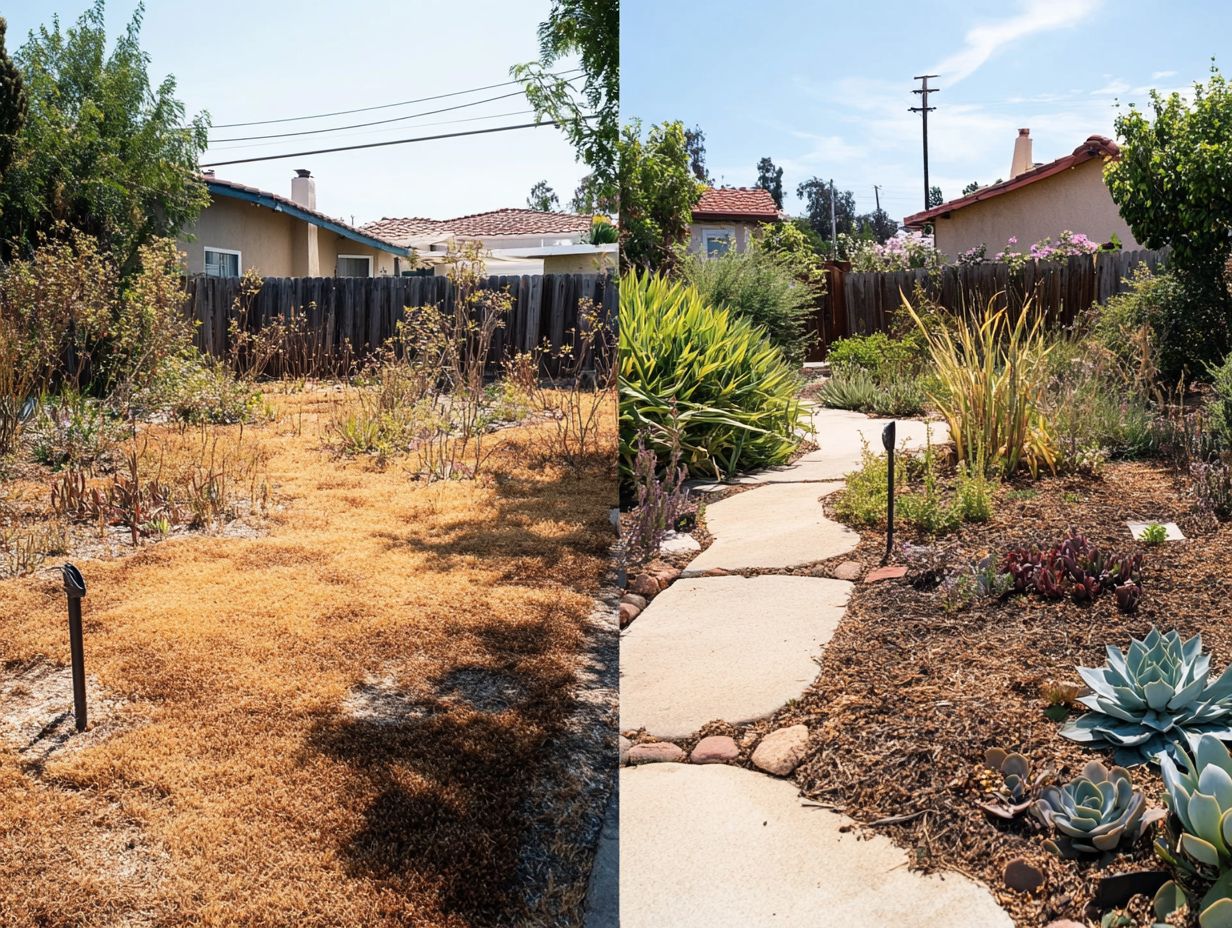
Drought can significantly impact landscaping choices as it limits the availability of water for plants and can damage the overall landscape design, making the importance of drought-resistant plants in landscaping more crucial than ever.
How can drought affect the health of plants in a landscape?
Drought stresses plants, making them more susceptible to diseases, pests, and the impacts of global warming. It can also lead to wilting, discoloration, and even plant death.
What are some water-efficient landscaping choices that can help combat drought?
Planting California native plants, using mulch to retain moisture, and installing a landscape irrigation system are great water-efficient landscaping choices to combat the effects of drought.
What are the long-term consequences of not considering drought in landscaping choices?
Ignoring drought in landscaping choices can lead to higher water bills, plant loss, and damage to the overall landscape design. To mitigate these issues, understanding the role of drought-resistant plants in landscaping is crucial. It can also contribute to water scarcity, environmental degradation, and the decline of essential pollinators like bees.
Are there any benefits to incorporating drought-resistant landscaping choices?
Yes, incorporating drought-resistant landscaping choices leads to a more sustainable and low-maintenance landscape design. It can also save money on water bills and help conserve valuable water resources.
Act now to protect your plants from drought stress. Regular checks can save your garden!
Start your xeriscaping journey today!
How can homeowners and landscapers prepare for and adapt to drought conditions?
Homeowners and landscapers can prepare for drought by choosing drought-tolerant plants and implementing effective watering methods. Regularly monitoring and maintaining the landscape is also crucial.
Seeking professional advice from local experts can help them tackle drought challenges specific to their region.


